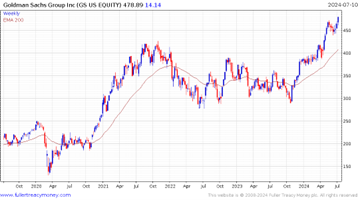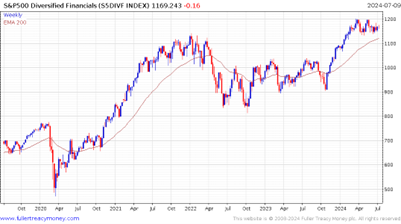Commercial real estate (CRE) risks are clear. A solid percentage of people now insist on working from home, for at least part of the time, and some companies are not fully remote. The loss of tenants in downtown areas represents a fall in foot traffic and a decline in taxation, and it inflates risk ratios. And yet, large financial firms like The Goldman Sachs Group Inc. (GS) are trading well, explains Eoin Treacy, editor of Fuller Treacy Money.
Bloomberg recently published a story titled “US Commercial Property Crash Is Set to Deepen the Pain Elsewhere.” It included a passage saying “Based on Oaktree analysis, the number of US banks at risk would exceed levels seen in the 2008 financial crisis levels if CRE values fell by only 20% from their peak. Office values there fell 23% last year, according to the IMF.”
It is not difficult to predict this will end in trouble for lenders and institutional investors. However, there is no sign of trouble right now. This is a chart of GS:

I have been cautious about Goldman’s business model. The company runs the hedge book for around half of all US hedge funds. The only asset class large enough and uncorrelated enough to absorb those flows is real estate. The bank’s asset management arm has a massive position in a troubled asset class.
So, why is it at new highs? The standing repo facility means access to limitless funds. Banks have been boosting loan loss provisions, so investors are less worried now than a year ago. There is a clear belief that the Federal Reserve will rescue the bank sector because that is what they have done at every sign of stress for the last 16 years.

The S&P500 Diversified Financials Index has been ranging for the last three months. But it is, so far, holding the break above the 2021/22 peaks.
The KBW Regional Banks Index has been ranging with a downward bias all year. The sector is heavily dependent on interest rates coming down soon to ease the burden of losses on their Treasury holdings. It has steadied over the last couple of weeks as 2-year yields broke below the 200-day MA.
The belief, backed up by experience, that the Fed always rides to the rescue is also a significant reason why gold remains firm. It is hedge against central banks making mistakes.
















